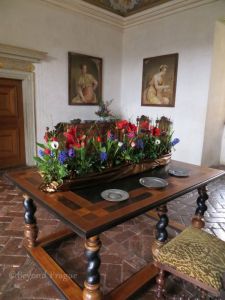One Thing and One Thing Only

Less than an hour by train east of Brno you will find the small town of Bučovice and its Renaissance style chateau.
While the chateau is neither the largest nor grandest of old Czech noble homes, it does come with the distinction of being one of a small minority of Renaissance chateaus in the Czech lands that were not converted from older structures. Bučovice is a true Renaissance structure from the ground up and has never been anything other than that through the length and bredth of its history.
Externally, Bučovice is a four winged building built in the palazzo in fortezza (fortified palace) style which was very popular in Italian Renaissance chateaus through the 16th and 17 centuries. The chateau features a three storied arcaded courtyard as well as a garden.
Internally, the chateau rooms that are available for visiting are notable for their ornately decorated and themed ceilings.
Boskovice to Liechtenstein

Commissioned by Jan Šembera (1543-1597) of the Moravian noble house, Boskovice, the chateau was built between 1575 and 1585.
One of the most powerful Moravian nobles of his day, Šembera was able to hire some very high profile Italian architects and tradesmen to carry out the construction and equally esteemed artists and craftsmen to tend to the interior decoration.
While Šembera was very rich and powerful, he was also the last male member of the Boskovice line when he died in 1597. Through marriage to Šembera’s daughters, Anna and Kateřina, many Boskovice holdings changed hands to the noble Liechtenstein family of Austria.
The chateau at Bučovice became property of Maximillian of Liechtenstein (1578-1643) when he married Kateřina in 1597. During his time as chateau owner, Maximillian commissioned the Mannerist style fountain in the chateau’s courtyard. The fountain was built between 1635 and 1637.
1681 marked a significant change for the chateau when it ceased to be used as a family residence and was repurposed for regional administration and then as the central accounting office for the Liechtenstein family in 1720.
Owing to such changes in the building’s reason for being, very little work was carried out after 1681 to change the Renaissance face it has kept to the present.
Since 1945, when all holdings of Germanic noble families in the Czech lands were siezed by the state, Bučovice chateau has been under state care.
Rabbits on the Ceiling

As mentioned earlier in this article, the interiors of the chateau are known for the themed and decorated ceilings in several of the representative rooms.
On a visit, one can see the “Hare Room” with themes of a world run by rabbits painted across the ceiling.
“Bird Hall”, as the name suggests, features a wide variety of exotic birds overhead.
The art in “Venus Hall” is dedicated to ancient mythology while the extensively stuccoed “Emperor’s Room” is themed on ancient Rome.
There is also the “Hall of the Senses” which contains paintings personifying the senses.
Other rooms featured in a tour of the chateau include the entry hall, library, dining room, kitchen, chapel and armory.
Paying a Visit and Learning More

Bučovice is quite easy to reach by rail from Brno in just under an hour as there is a line from Brno that includes a stop at the town. The chateau is a short walk from the town train station.
The chateau is open for tours between April and October with variable hours depending on the time of year. Non-flash photography is permitted during tours.
There is a small café on the chateau premises to refresh yourself after a tour.
Aside of tours, some rooms in the chateau are available for rental for weddings or other special occasions.
The following websites will give you further information on visiting hours of the chateau and what’s on view there:
